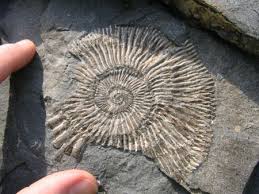|
Much of what is displayed at the Buffalo Nations Museum is fossil relics from ages gone by. Have you ever seen fossils at a museum and wondered where they came from? Some museums display the story of the fossil's finding, others do not. Children hope that they'll be able to find fossils by digging in the backyard of their home. Are they right? This article is all about finding fossils - where they're likely to be, how scientists are able to guess their locations, and how they get them out of the ground without destroying them.
A fossil is defined as the preserved remains of organisms such as plants and animals from the distant past. The word fossil literally means "something you dug up" in the original Latin. Fossils are different from artifacts, which are tools or other objects that have been formed by humans. Therefore if you find an imprint of a plant in the rock under your home, you have found a fossil. But if you find an old Native American arrowhead, you have found an artifact, not a fossil.
People who study and search for fossils are called paleontologists. Paleontologists use the fossils they find to learn more about how things were a long time ago. They generally split their time three ways: finding fossils, studying fossils, and writing about their findings. They spend a lot of time away from their home in remote places looking for fossils in places where other fossils have been found, such as in the deserts of New Mexico, in the badlands of Alberta, and in the driest parts of Western Australia.
You would think that in some of these vast areas, like Alberta's Badlands, where so many fossils have been found over such a huge space, that it would be very tempting to bring in a truck and simply wash away the earth to reveal dozens or even hundreds more important finds. Unfortunately, while this technology is ideal for digging without harming man-made infrastructure and is even safe for environmentally sensitive sites, it's still potentially damaging for the purposes of discovering fossils.
Fossils are very rare and easily damaged, because a specific set of special circumstances has to occur before an animal, plant, or trace can be preserved. It must be covered by sediment soon after the animal dies or makes a print so that the area is protected from the elements. Then the rock dries out and hardens, creating a mold around the object. In a lot of cases, the object itself dissolves and all that is found in the rock is the imprint it made in the rock. Therefore fossil hunting sometimes involves looking for "holes" in solid rock with sonar, and carefully chipping away around it.
The most common places for fossils to be found are in very dry desert areas that were once wet, such as ancient lake beds and the bottom of prehistoric oceans. There are signs in the rock, such as bands of ancient silt, to indicate where these old wet areas were. However, that doesn't mean all fossils are found in these areas. It's still possible to dig one up in your backyard. In fact, most of the biggest fossil finds in history were located by accident.
Image of a fossil:

| 